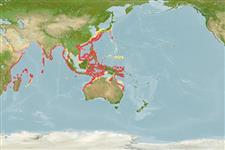Common names from other countries
>
Carangiformes (Jacks) >
Carangidae (Jacks and pompanos) > Caranginae
Etymology: Decapterus: Greek, deka = ten + Greek, pteron = wing, fin (Ref. 45335).
More on author: Bleeker.
Environment: milieu / climate zone / depth range / distribution range
Ökologie
seewasser riff-verbunden; tiefenbereich 100 - 300 m (Ref. 3197), usually 150 - 300 m (Ref. 3197). Deep-water; 38°N - 26°S, 34°E - 148°E
Indo-West Pacific: East Africa to the Philippines, north to southern Japan, south to Western Australia.
Length at first maturity / Size / Gewicht / Alter
Maturity: Lm 17.2 range ? - ? cm
Max length : 45.0 cm TL Männchen/unbestimmt; (Ref. 3197); common length : 30.0 cm FL Männchen/unbestimmt; (Ref. 3287)
Rückenflossenstacheln (insgesamt): 9; Rückenflossenweichstrahlen (insgesamt): 28-29; Afterflossenstacheln 3; Afterflossenweichstrahlen: 22 - 25. Deep bodied compared to similar species (Ref. 48635). Body color bluish green above, silvery below; caudal fin bright red. Sometimes a yellow mid-lateral stripe (Ref. 48635). Opercle with a small black spot; margin of opercular membrane smooth. 31-38 scutes.
Adults are found in deep waters. They feed on small planktonic invertebrates (Ref. 5213). Occasionally seen in small groups along reef slopes at moderate depths. Mainly known from trawls and shows red tail after capture (Ref. 48635).
Paxton, J.R., D.F. Hoese, G.R. Allen and J.E. Hanley, 1989. Pisces. Petromyzontidae to Carangidae. Zoological Catalogue of Australia, Vol. 7. Australian Government Publishing Service, Canberra, 665 p. (Ref. 7300)
IUCN Rote Liste Status (Ref. 130435)
CITES (Ref. 128078)
Not Evaluated
Bedrohung für Menschen
Harmless
Nutzung durch Menschen
Fischereien: kommerziell
Mehr Information
ReferenzenAquakulturAquakultur ProfilZuchtlinienGenetikElectrophoresesVererbbarkeitKrankheitenVerarbeitungMass conversion
Tools
Zusatzinformationen
Download XML
Internet Quellen
Estimates based on models
Preferred temperature (Ref.
115969): 11.5 - 22.4, mean 15 (based on 274 cells).
Phylogenetic diversity index (Ref.
82804): PD
50 = 0.5010 [Uniqueness, from 0.5 = low to 2.0 = high].
Bayesian length-weight: a=0.01413 (0.00931 - 0.02143), b=2.98 (2.85 - 3.11), in cm Total Length, based on LWR estimates for this species & Genus-body shape (Ref.
93245).
Trophic level (Ref.
69278): 3.4 ±0.45 se; based on food items.
Widerstandsfähigkeit (Ref.
120179): mittel, Verdopplung der Population dauert 1,4 - 4,4 Jahre. (K=0.63).
Fishing Vulnerability (Ref.
59153): Low vulnerability (25 of 100).
